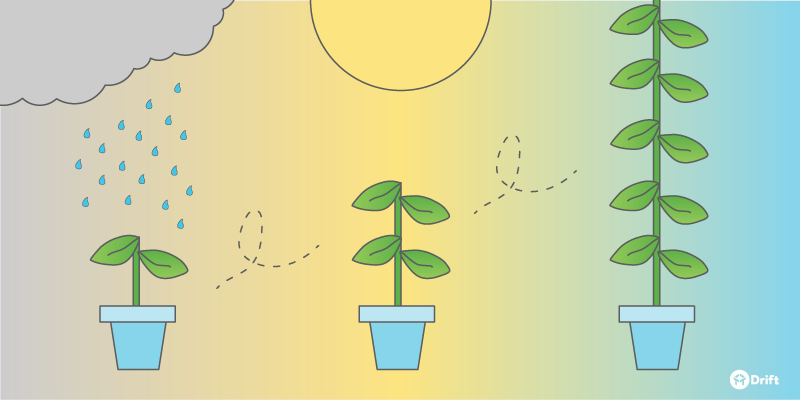
138x.
Not bad right?
OK OK. I know what you’re thinking.
It’s pretty easy to make those numbers sound impressive when you’re growing from nothing.
But it’s not exactly like we grew from one visitor to 138 visitors.
We grew from 198 visitors in October to 27,369 visitors this month as of writing this post.
And since this has been the first time anyone on our team has truly launched and managed a blog from scratch, we thought we’d share some of the things we’ve learned so far along the way about content marketing.
PS. You can get try Drift for free right here.
6 Things We’ve Learned About Content Marketing
1. Blogging for your business is an investment, not a get rich quick scheme.
This is a popular piece of advice when it comes to blogging, and content marketing — and we knew this going in — but it’s way different when you actually feel it first hand, and worth mentioning again since we live in a world of marketing hacks and tricks.
As Erik said to me while I was writing this post: when it comes to blogging, first you get rained on a for a while, and have two readers, but if you stick with it and do a good job, eventually the sun will come out and it will grow. That’s a good way of putting it (and the story behind the image for this article that Erik made).
And this doesn’t really hit you until you write 10, 20, 30 posts, and you feel like the world still hasn’t noticed your stuff.
But there’s one thing to know as you’re going through the grind of trying to grow a blog for your business: the grind pays.
The chart below shows the breakdown of traffic to our blog this month by the date that the post was actually published (so for example, 10.5% of our traffic in June came from posts we wrote in November). Look at the spread of all those months!
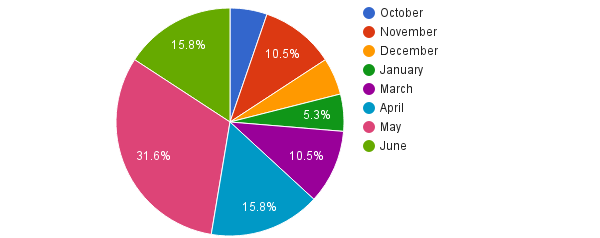
And even if we were to take away all of the traffic to our blog from the last 60 days — twelve percent of our all-time traffic is coming from old posts that date all the way back to October.
Speaking of October, this article about product marketing that we published that month is one of the best examples of the long term impact that content can have.
Not only is that post still driving traffic back to our blog today, but it’s driving more traffic every month as it continues to climb up Google’s search engine results: 22 clicks in April, 106 clicks in May, and 152 clicks so far in June.

And all we’ve had to do since originally publishing and promoting that post is a little bit of outreach to get a few more backlinks, and we recently updated the content to be much more thorough once we noticed that post was starting to rank.
Today, the post is in the the fourth spot on page one for “product marketing” — a keyword that gets been 5,000 and 7,000 searches each month (and the third listing is actually HubSpot linking to our post).
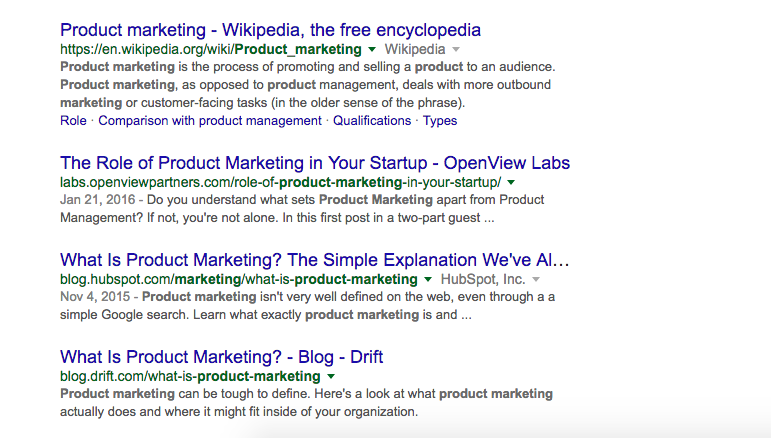
That’s one example from one post to show how the investment in blogging pays off: it compounds over time. The work we put in to write that post in October is still paying off today. If we were running ads in October and then stopped them, the traffic would stop too. That’s not the case for content.
This is something that we knew about content going in, but free traffic and free leads have a different ring to them when they’re actually for your business.
2. Quality over quantity doesn’t just sound nice: it’s the only way to build an audience today.
Our post about product marketing that we just talked about is a great example of this: quality content works.
We set out to create the best piece of content about product marketing, and that started with talking to 10-15 product marketers and finally coming up with a clear definition for what product marketing does and where it fits inside of a typical SaaS business.
We didn’t set out to generate thousands of clicks and rank on page one — we set out to create a piece of content that product marketers (our core audience at the time) would love and find helpful. Plain and simple.
Creating quality content is another one of those lessons that you already know and you know it works. But it’s much harder to actually act on when it’s a Monday morning, you’re planning out your work for the week, and you know you need to publish something new.
Very rarely have we created something great last minute.
That doesn’t mean you need to take weeks to write something new, but a little bit of effort goes a long way, especially today.
We live in a world of crap content.
I know it, you know it, and Buzzsumo confirmed it with their stat that 50 percent of content gets eight shares or less.
And yet we keep publishing stuff that we wouldn’t read or bookmark ourselves.
This is what happens when you “have” to publish something (i.e. you’re measured on traffic or, gulp, the number of posts you publish).
But there’s only one way to build an audience with content marketing today: you have to create stuff that people actually want to read.
At Drift, I wish we really hammered on this from day one. And it’s my fault — I fell in the trap of wanting to crank out more content.
Some of it was good, some of it wasn’t. But when you publish a post and two days later no one has read it, the natural reaction is to go and write something else. I guess it’s human nature.
But now, it’s crystal clear that quality content (over quantity) is the only way to grow today. Here’s what I found while pulling together this post:
- We’ve published 204 posts since launching our blog.
- 76 percent of the total traffic to our blog has come from twenty percent of our posts. That’s just 40 posts — driving three quarters of our total traffic.
- And if we take things even further, 60 percent of our traffic comes from 20 posts — that’s just 10 percent of the 204 posts we’ve published.
That’s why we’re publishing less content, but spending more time creating it. The good stuff makes the biggest impact.
3. You need to spend as much effort promoting new content as you do creating new content.
The RSS days are behind us.
People aren’t just going to come to your blog just because you published a new post. You have to tell people about your stuff. You have to promote your content.
And this is another reason why focusing on quality over quantity works better all across the board:
When you’re publishing three to five new posts per week to just crank out more content, how do you figure out which stuff to promote? You could email your list three times in a week, but then everyone will hate you. Or you could send one email with five links, but then no one will actually click any of them.
That approach won’t help you build an audience of loyal fans. But creating quality content and spending the time and effort to promote it to the right people will.
Promoting Content
Until recently, if we published a new post and didn’t promote it, very few people would find it.
And even still today, if we really want to get a lot of eyeballs on a new piece of content, we have to tell people about it.
This might not be ground breaking, but I think it’s one of the biggest mistakes people make with content marketing: they spend all of their time on the content and none of their time on the marketing.
Now, this doesn’t really work the same if you create crap content. But if you just spent hours creating a killer piece of content, why not put in the same amount of effort to make sure that people read it?
Unfortunately, there’s no magic bullet for content promotion. You need to put in the work and hustle for distribution.
Outside of promoting our content on our social media channels, here are the channels that have had the biggest impact, and a little about how we’ve thought about each one.
Communities
In the content marketing world, there’s a lot written about the power of community sites like Reddit, Inbound.org, and GrowthHackers.com
These sites can be super powerful because they have thousands of members (millions on Reddit) and the people who visit these sites every day are often influential in their own circles — sneezers as Seth Godin would call them. So marketers flock to these sites to post their links in hopes of capturing some small percentage of that traffic — but the majority of the links posted on these sites get no traction at all.
That’s because most marketers just blast their own links everywhere. Another channel ruined by spam.
But there’s a secret to unlocking traffic from community sites: treating the members like real people.
How would you try to get their attention in person? In most cases, you’d probably say hello and try to start a conversation with them (not just start firing thoughts and ideas their way).
That’s the approach that you need to take to with communities, too. When you post there, be genuine. To try to start a conversation – not just shove a link at someone.
Here’s an example of a post on Inbound.org that had 138 upvotes, 73 comments, and was at the top of Inbound.org for a full week:
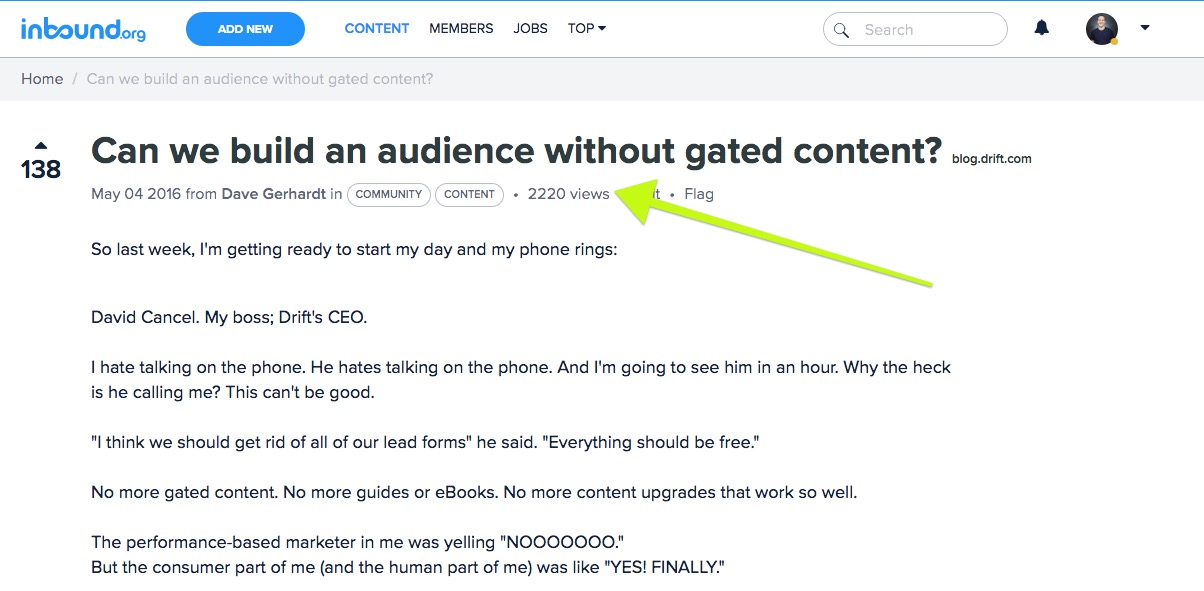
This post worked so well because the topic was extremely relevant to this community of marketers, and we didn’t blindly post a link to everyone that felt like spam or self promotion.
We told a story and tried to start a discussion around a topic that we thought people in the community might have an opinion on.
As a result, this one post drove 600+ new people back to our blog:

And this was not a one hit wonder on Inbound.org. We posted on the site once a week in May with this approach, and each new post averaged over 100 upvotes and 45 comments:

Communities can be amazing, but you have to treat them with respect and post your link subtly. Your link should be a way to learn more about a topic if people find the discussion interesting — not the only reason you are posting on one of the communities in the first place.
It also pays to try and respond to every single person that comments, too. This lets the rest of the community know you’re a real person, vs someone who disappears immediately after they post a link on the site.
Influencers and Outreach
We have been lucky to have a crew of advisors that have big audiences and are influential to our target audience — people like Hiten Shah, Mike Volpe, Mark Roberge, Brian Balfour, Mike Troiano, and Mitchell Harper.
They have been a huge help tweeting about our content, sharing links in their newsletters, and talking about us in the things that they write.
As helpful as they’ve been in helping us spread the word, we’ve also spent a good amount of time doing our own outreach to people who don’t already know us — whether it’s outreach for a backlink, outreach to try and get someone to share our content, or just outreach to say hi and get on someone’s radar for the future.
And throughout the process of doing all of this outreach, we’ve stumbled on to a little template that can make outreach way more effective: asking for permission first.
This one seems so obvious, but for whatever reason, the rules of being a human and a good person sometimes completely go out the window when it comes to online marketing. Here’s how the typical outreach process goes:
- Find someone’s email.
- Email them a link to your article and ask them to share it or link back to it — even though you’ve never talked to them before in your life.
Why would someone want to share your stuff if you cold email them out of nowhere and then jam a link down their throat? All of us in marketing have probably been on the recipient of an email like this.
Here’s the better way to do outreach: ask for permission first.
Here’s an email that I typically use:

And the key to that email is this one line:
Let me know if you want to check it out and I can send over a link.
There’s no link, and not even an ask to share. I’m just introducing myself and asking a stranger if I have their permission to send them something.
When you do that, here’s what typically happens next:

Once they’ve replied to you, then you have the right to ask them to share or link back if they find it interesting. This is basically a double opt-in approach to getting people to promote your content.
Not only is this a much friendlier approach, but it’s a much more effective approach. Why? Because you’ve treated the person that you want to share your stuff like… a real person. And as a person, they are more likely to do you a solid and spare you a tweet or a backlink vs. feeling like you’re just using them for a transaction.
Our email list has consistently been the number one way to drive traffic back to our blog, but for a while, we were making a huge mistake with our emails.
Each email we sent would have multiple links and CTA’s. We were trying to cram everything into one email.
And this goes back to what we were talking about earlier — when you’re creating a ton of content, you want to promote it all.
You want every post to drive a ton of traffic.
But cramming everything into one email just doesn’t work.
Instead, we switched to sending one email each week. That’s it, unless we have a big product announcement to make or something special.
Even if we publish three new pieces of content that week, we only send one email, and each email only has one link. Not three, not two. One. Only.
This was the hardest change to make, but the results don’t lie. Email works much better when you pick one thing that you want people to do when they read it, and now it’s something we think about with every single email.
Maybe in the future when we have hundreds of thousands of subscribers we can add a few more links in the email, but for today, one link to content works the best. We can always send another email the next week.
The other thing that has had a huge impact when it comes to email is getting other people with big lists to promote our content in their emails.
Our content has been featured in Hiten Shah’s weekly SaaS email, Mattermark’s daily email, Mind The Product, OpenView and more.
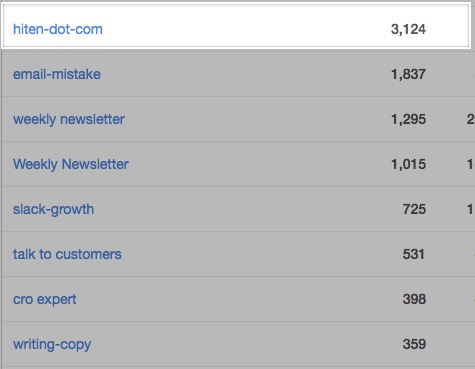
But beware if you’re hunting people with huge email lists: you don’t get that much traffic back to your blog if you’re one of 10 links in a newsletter that has 100,000 subscribers and a two percent click through rate.
It’s usually better to find a smaller, targeted list of people.
4. Spend more time focusing on topics than keywords.
We’re in the sales and marketing software industry.
There are literally thousands of other companies in this space.
If we set out to build a content strategy around high traffic keywords in this space like “live chat” or “messaging app” we’d still be sitting at a few hundred visitors a month with all of our content buried somewhere in the depths of Google search results.
So instead of hunting a list of keywords like that, we made the decision to focus on topics that were relevant to our target audience (like product marketing, growth marketing, product management and sales) and then building out a library of great content around each particular topic.
Some people call it the spoke and hub model, some people call it creating site pages. Either way, this content strategy is effective because it forces you to keep things simple, create great stuff, and it makes sure your old content is still doing the work and pulling in new traffic for you.
The process looks something like this:
- Research and select a topic.
- Create one 10x piece of content to be the definitive guide or resource on that topic.
- Create a bunch of additional content on that topic (individual articles) and link back to that one main piece of content.
Anum Hussain has a great presentation on this topic and how they used this strategy for HubSpot’s sales products if you’re interested in learning more and going deeper.
5. Looking at Google Analytics can be interesting but it won’t help you get more traffic.
Campaigns, sources, mediums, referral traffic, goals, webmaster tools.
I can never get enough. Google Analytics is so much fun to look at.
And it’s also a huge waste of time as your trying to build an audience.
All of the big jumps in traffic, all of the new email subscribers — heck, all of the big spikes in new signups for Drift — have all come from big swings, not little things we’ve found in Google Analytics.
And I know. We’re supposed to love data. Marketing needs to be data-driven! Marketers need to be analytical and focus on optimization!
But when it comes to startups and your early marketing strategy, we tend to go too far.
Whether we had 1,000 visitors or 10,000 visitors – how much can you really optimize for at that stage?
You could spend an hour digging through Google Analytics or an hour starting to create your next great campaign or article. Which would pay off more?
If you want to grow faster, you need to focus on taking big swings — not little tweaks.
Every time we take a big swing, something good tends to happen.
Analytics are fun to play around with, and you can usually find an interesting nugget or two, but at this stage, analytics rarely help you grow faster.
6. Don’t worry about being (or finding) a perfect writer.
This last learning might actually be the most important.
If you’re going to invest in content, you need to be able to write so people can understand you — that’s it.
You don’t need to be (or hire) the world’s best writer
You’re not writing a novel.
You’re usually writing a blog post.
Don’t get too cute. Don’t try to be too catchy or pithy. Just try to write so people will understand you.
Remember this lesson from advertising legend David Ogilvy:
“Do not, however, address your readers as though they were gathered together in a stadium. When people read your copy, they are alone. Pretend you are writing each of them a letter on behalf of your client. One human being to another, second person singular.”
Can We Send You An Email? (Only Once A Week)
I talked about how we send an email once a week in this post, so I have to ask – can we send it to you, too? 8,000 people get it every week, and if you want to join them, just put your email address in right here:



